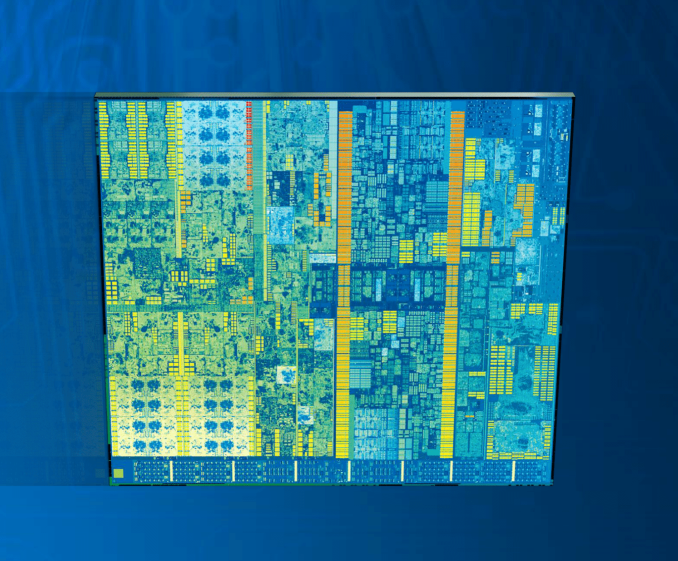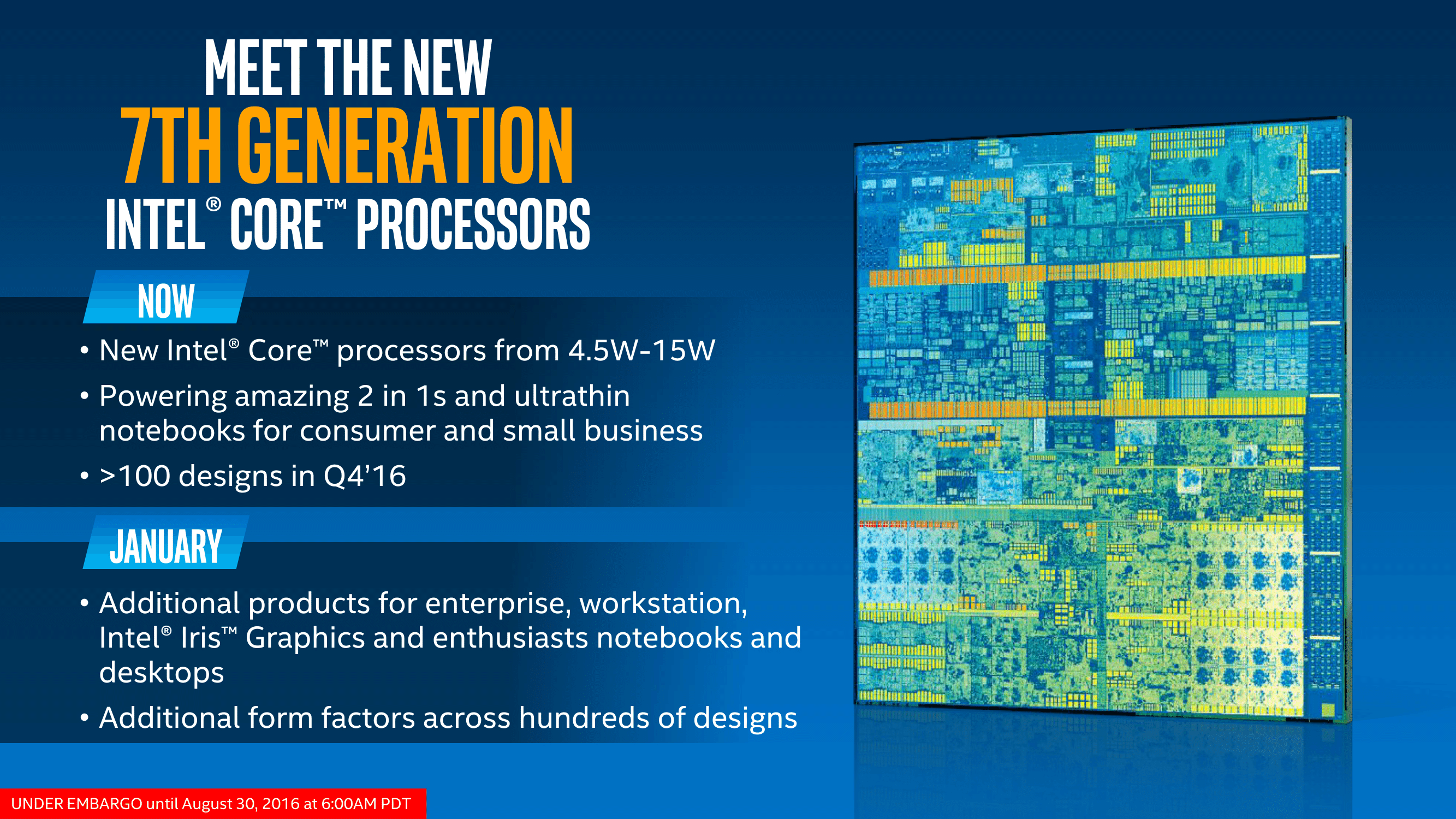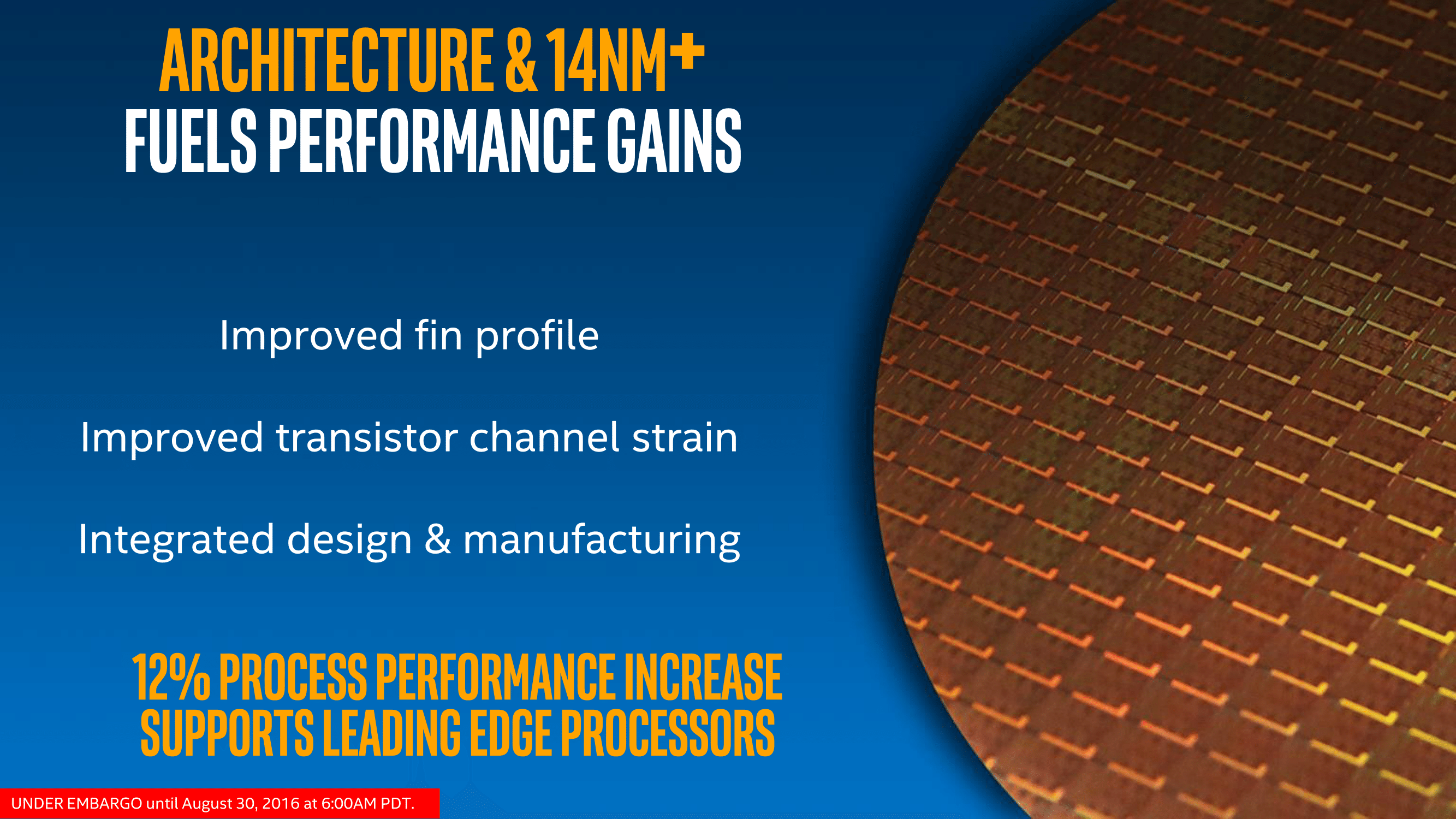Intel Announces 7th Gen Kaby Lake: 14nm PLUS, Six Notebook SKUs, Desktop coming in January
by Ganesh T S & Ian Cutress on August 30, 2016 9:00 AM EST- Posted in
- CPUs
- Intel
- 14nm
- Kaby Lake
- Gen 9
- Speed Shift
- Turbo Boost

When Intel first announced the shift from the dual-stage ‘Tick-Tock’ methodology that had driven their core CPU design teams for over a decade into the three-way ‘Process, Architecture, Optimization’ paradigm, there were questions as to how much of the final stage, the Optimization, would actually change the way CPUs were presented or offer upgrades in performance. At the time, ‘Kaby Lake’ as the name for Intel’s third crack at their 14nm process was well known, but users wondered if it was just another Devil’s Canyon (better overclocking) or a full on CPU launch. Well the answer is the latter, and the launch is staggered between today and January. Roll on Kaby Lake. Is that Kah-bee Lake, or Kay-bee Lake?
Tick-Tock to Process-Architecture-Optimization (PAO)
Intel’s two year processor cadence of Tick-Tock allowed the company to alternate reducing the lithography node (a tick) with an upgraded microarchitecture (a tock) with modest gains of performance. Each stage of the Tick-Tock would take 12-15 months, with new lithography nodes taking longer and longer to reach maturity. Eventually it has gotten to a point where 14nm took too long to become pervasive in Intel’s product stack. For a manufacturing company and a CPU company, slowly rolling out Broadwell notebook and low power parts and then gutting the mid-range desktop was the result of the troubles of bringing 14nm to the prime time. Now in 2016 we have the launch of full-sized Broadwell-EP server parts running up to 22 cores in a 145W envelope, but the low power parts are a couple of microarchitectures ahead. We have this strange situation of a stretched landscape, partially driven by markets but also for manufacturing.
The move from Intel’s 14nm process to 10nm is a long, slow burn, taking much longer to develop than any process previous. We first saw 14nm in Broadwell mobile CPUs in Q3 of 2014, almost two years ago, and 10nm still isn’t on any public roadmap for early 2017. With the tick-tock strategy, and the launch of Skylake in mid-2015, this would leave Intel without a new CPU launch for almost two years, which is unheard of from Intel. Also, Intel’s partners rely on product cycles to announce and launch new products to generate revenue. To fill the gap, plus with a few other techniques, Intel moved to Process-Architecture-Optimization, or PAO for short.
This means three bites of the cherry for 14nm before we see 10nm in prime time. First it was Broadwell, then Skylake, and today Intel is announcing Kaby Lake. As part of the release, Intel has mentioned that a number of key benefits for Kaby Lake will be based on an optimized 14nm process, called 14PLUS (or 14nm+, 14FF+). This process as a quick summary has a higher fin height and larger pitch, essentially giving a less-dense set of transistors that have more room to breathe. Normally a larger pitch means more voltage required, but this is offset by the fin height and Intel says is good for another few hundred MHz for performance. The less-dense design, in theory, may also help in overclocking, however we will have to wait until January to see those results.
Today’s Announcement
The reveal today covers several aspects of Kaby Lake. First is the actual SKUs that will be launched, which consist of three Kaby Lake-Y parts around 4.5W aimed at high-end tablets and 2-in-1 devices and three Kaby Lake-U parts at 15W for notebooks. Both sets of KBL-Y and KBL-U CPUs will feature in mini-PCs as well, so we expect to see the usual array of Zotac and ECS announcements in due course. We have details on all six CPUs to give you, including the new Core M branding regime for the 4.5W family of parts.
The pre-briefings we have had go into some detail regarding changes in the processor, particularly regarding the new enhanced media blocks inside the GPU to support new encode/decode features. The graphics power, in terms of EUs or the microarchitecture, hasn’t changed but the fixed function hardware has some nice upgrades for an updated version of Gen 9 graphics aimed at the upcoming era of 4K support. Ganesh has gone into detail for us over what that means, especially where power and battery life is concerned for anyone creating/consuming 4K content.
Kaby Lake also has an updated Speed Shift package, to accelerate the work already done with Skylake in boosting the performance of the CPU quicker to save power. Intel call it a refinement in the mechanism of handing frequency control back from the OS to the CPU, however ‘Speed Shift v2’ is an adequate moniker to show the upgraded difference.
Intel hasn’t gone into much detail regarding the new 14nm+ process itself in terms of specifics, but has listed a number of performance gains that come out of the new CPU. The fundamental microarchitecture between Skylake and the new Kaby Lake parts is practically unchanged (DMI 3.0 now allows PCIe 3.0 x4 NVMe drives from the integrated PCH), but the updated fin profile and reduced ‘strain’ by the larger fin pitch is being quoted as giving a 12% performance increase due to process alone, typically through additional frequency for the same power. The main benefits to KBL will be in that frequency due to the 14nm+ process as well as the new media capabilities.
As always, Intel consistently emphasizes the difference between a new notebook/2-in-1 based on a 15W Kaby Lake processor compared to a 5-year old device, such one based on a mobile Sandy Bridge ULV part. Intel continually sees its market revolving around new experiences created by new form factors, and to generate revenue requires people to upgrade and decide how these new experiences can influence an upgrade. Intel expects to have over 100 Kaby Lake system designs in the consumer channel by Q4, including 120+ using Thunderbolt 3, 100+ using Windows Hello (either via a Real Sense camera or a fingerprint sensor), 50+ designs with 4K UHD as a primary feature and 25+ designs with contact enabled pens. Kaby Lake should be pin compatible with Skylake based designs, meaning that for a number of cases we will simply see a drop in, but others will have new design IDs on show.














129 Comments
View All Comments
Arbie - Tuesday, August 30, 2016 - link
How did we get to 7 pages of comments and no flame war yet? Who's not here?fanofanand - Tuesday, August 30, 2016 - link
Vlad and ddriver. Once they get here all hell will break loose like usual.th3z3r0 - Tuesday, August 30, 2016 - link
Seems like a decent upgrade for notebooks and for 4k videos.http://www.notebookcheck.net/Kaby-Lake-Core-i7-750...
MrSpadge - Tuesday, August 30, 2016 - link
"We are told that transistor density has not changed, but unless there’s a lot of spare unused silicon in the die for the wider pitch to spread, it seems questionable."With the taller fins they're increasing the drive current which each fin provides. A transistor uses several fins, depending on how much current it has to drive. By using taller fins Intel can get away with fewer of them and hence can place them further apart and reach the same transistor density.
negusp - Tuesday, August 30, 2016 - link
Doh! There goes my hopes for proper Skylake support on linux.Morawka - Tuesday, August 30, 2016 - link
ok so lots of marketing BS in this article, not anand's fault, rather intel's.So what i'm seeing is virtually no IPC improvements, not even 1-2%, all gains are coming from optimized max turbo clockspeeds. GPU is what see's the majority of the improvements, however there are a few fixed function blocks on the CPU that are new for VP9.
Intel is doing mobile first yet again. I dont blame them, those mobile chips are waay overpriced and have the most profit margin. $300 core M CPU anyone?!?!, or how about a $450 quad core mobile i7. Yeah same ol tricks coming from intel. Won't be long before intel is irrelevant, i'd say within 10 years, mostly due to AMD's recent IPC gains and ARM taking a bigger part of the market if the Intel Fabbed Apple iPhone Chips rumors pann out. Some say apple will move all their mobile to arm, and they will all be fully custom by apple, but made by 10nm and 7nm intel foundries.
zodiacfml - Tuesday, August 30, 2016 - link
I disagree on most points but I have to agree with you with Intel's current strategy. I know they can release the 10nm parts this year. It might painful and expensive and works for the near-term, but as ARM continues to build bigger and faster parts, the gap is becoming smaller throughout the years.Next thing they'll know (Intel), people will start using PCs based on ARM. Microsoft's strategy of releasing and maintaining an ARM based OS (Windows phone) wasn't bad as it looks now. Intel is ignoring the mainstream/consumer market who funds the R&D and tools required for the lucrative products in the server/enterprise market.
Meteor2 - Wednesday, August 31, 2016 - link
Well, Windows on ARM didn't work out (RT), unlike Android on x86, which is good. But maybe with UWP Microsoft will have another go -- they've opened pathways to get legacy software on to UWP, which would enable processing on ARM.tobi1449 - Tuesday, September 6, 2016 - link
No it doesn't. Full UWP-Apps will run on any platform, but legacy software (i.e. x86 software) that has just been packed as UWP App (so it can be sold via the Windows Store) won't be able to run on anything but x86 platforms.Cliff34 - Tuesday, August 30, 2016 - link
For me, looking to buy a new laptop end of this year, is hoping that this will drive Skylake laptops prices down further. However given that Kaby Lake is probably releasing to retail Q1 next year, I don't think I will see much in that beyond the savings from the holiday pricing.